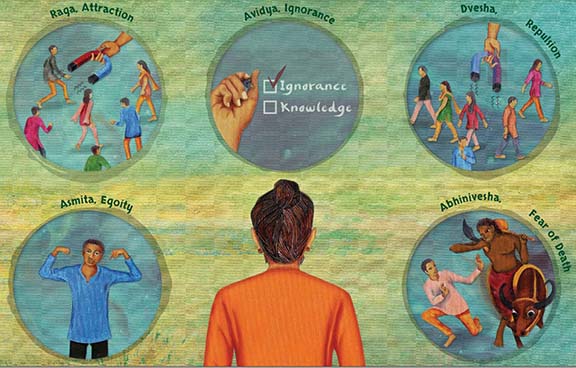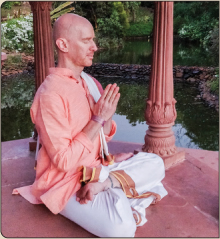
Illustration of the five kleshas. Artwork by Baani Sekhon.
In his translation and commentary on the Yoga Sutras of Patanjali, Swami Satchidananda gives this introduction to the five kleshas: “Sri Patanjali gives the obstacles (kleshas), which will then be explained one by one. The order is significant: because of ignorance of the Self, egoism comes. Because of egoism, there is attachment to things for the ego’s selfish pleasure. Because sometimes the things we are attached to do not come or are taken away, hatred for those who got in our way comes in. And, finally, because we are attached to things and afraid of death, there is clinging to life in the body.” In this article, Eddie Stern gives an overview of each of the five kleshas.
Avidya is an incomplete knowing of who we are. Vidya is knowledge, and the syllable a indicates, in this case, the opposite. If vidya is knowing, then avidya is a not-knowing, misperception or mis-cognition. It is not total ignorance, for indeed we know many other things, but we do not know our true nature. Avidya is the ground for all of the other kleshas. In fact, it could be said that there is really only one klesha, avidya, because contained within avidya are the other four, which do not exist independently of avidya.
Asmita is the misidentification of identity and creation of narratives that occur when we do not truly know who we are. Asmi means “I,” and ta means “-ness” or “the quality of.” Asmita is the limited identity of a constructed self. When we have an incomplete picture of who we are, we fill in the blanks with peripheral identities, stories and false narratives that we spend our lives enforcing, defending and concretizing. This narrative constructs itself by holding on to likes and dislikes.
Raga and dvesha are our attachments to likes and dislikes, the things that we are attracted or drawn to (raga) as well as to the things to which we are averse (dvesha). They are both attachments. We are attached to the things that we find superior, and no less attached to the things that we find inferior or distasteful. The attachments to the things we dislike are often more troubling than the things we like. For example, if we are fans of one sports team, that can set us against every other team in the league. Attachment to one team makes us averse to twenty.
Abhinivesha is clinging to life and the fear of extinction that occurs when all we know is our story, desires and aversions. When we take them to be real, we fear that without them we will cease to exist. Hence, the clinging to life, the clinging to our constructed narratives, the clinging to raga and dvesha. On a biological level, life perpetuates itself. The impulse to procreate, for example, is nature’s tight grip on its perpetuation. Since this is an impulse that is intrinsic to creation, it naturally flows in all beings, even, as Patanjali says, in the wise.
Through the practices of Kriya Yoga, all of these, we are told, will weaken their hold on us. The kleshas are like a covering over the light of our inner awareness. When that covering is thinned, the light of awareness shines more brightly through the covering, through the veil, and that pulls us inwards towards the radiance of samadhi. But the question is, how? How will a headstand, how will a breath held in pranayama, how will the simple repetition of a mantra reduce my fear of death? How will those practices change my false narrative about my life based on my fleeting desires. How will they remove all traces of my stories so that the only story left is the story of no story at all, of pure consciousness?
Quotes on the Kleshas
“One of the strange but ever-present states in all beings is the desire to live forever. Even those in the presence of death every day have this illogical desire. This is what inspires the instinct for self-preservation in all of us.”
Sri TKV Desikachar,
Reflection on Yoga Sutras of Patanjali
“The means of Samadhi and the attenuation of Klesha is Kriya-Yoga, i.e., calmness of the body and the senses through Tapasya, the predisposition to realization through Svadhyaya, and the tranquility of mind through Ishvara-pranidhana.”
Swami Hariharananda,
The Yoga Philosophy of Patanjali
“In the Yoga Sutras, 1:24, Patanjali says: “The Lord (Ishvara) is untouched by [the five] kleshas (troubles), karma (action), vipaka (habit), and ashaya (desire). Since the Lord is free from these eight imperfections inherent in creation, the yogi who seeks union with God must likewise first rid his consciousness of these obstacles to spiritual victory.”
Paramahamsa Yogananda,
God Talks with Arjuna, The Bhagavad Gita
About the Author:
 Eddie Stern is a Yoga instructor and author from New York City. His latest book is One Simple Thing, A New Look at the Science of Yoga and How it Can Change Your Life, and his newest app is “Yoga365, micro-practices for an aware life.” His daily, live Yoga classes can be found on www.eddiestern.com
Eddie Stern is a Yoga instructor and author from New York City. His latest book is One Simple Thing, A New Look at the Science of Yoga and How it Can Change Your Life, and his newest app is “Yoga365, micro-practices for an aware life.” His daily, live Yoga classes can be found on www.eddiestern.com
(Reprinted from Hinduism Today)

